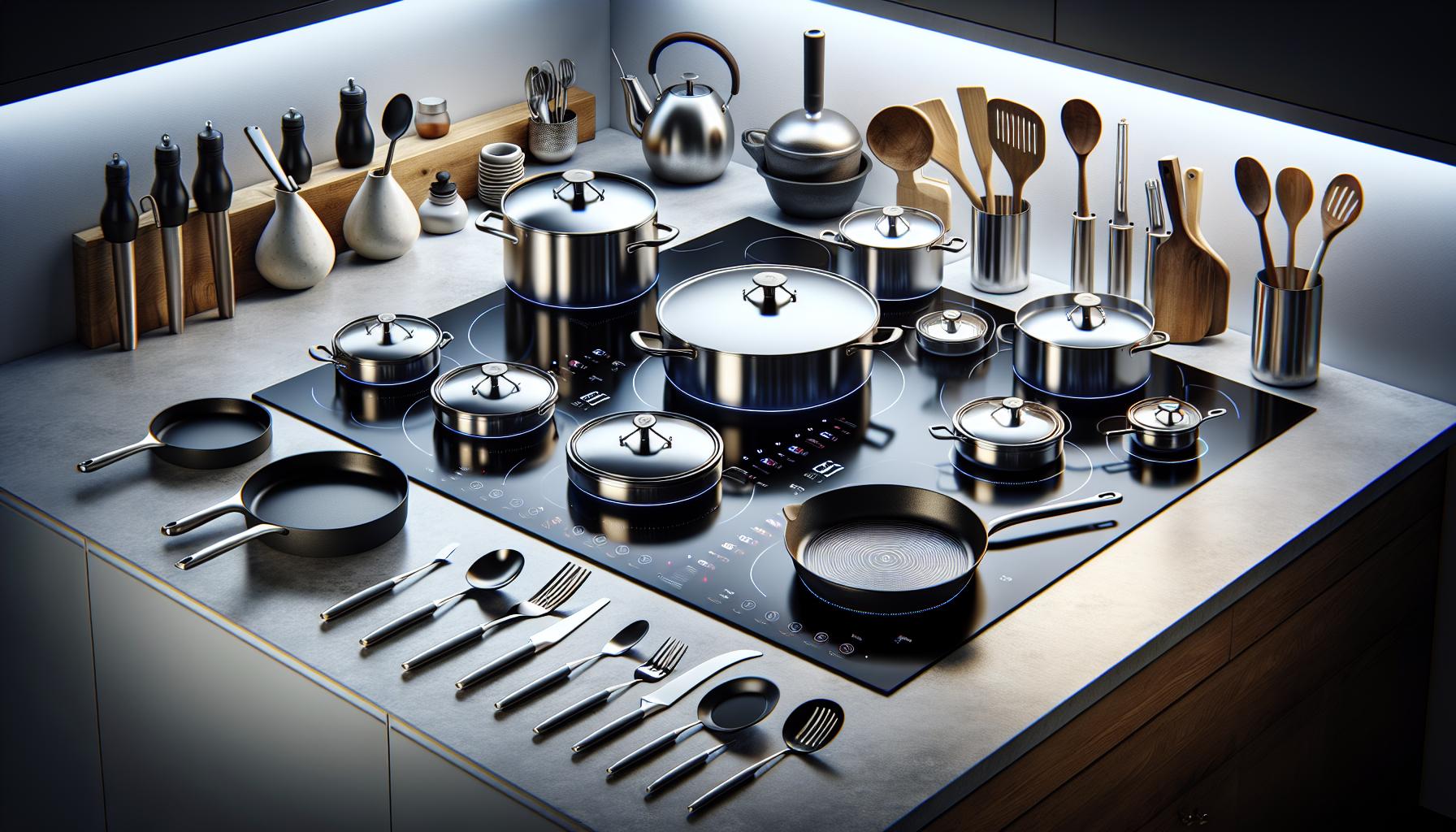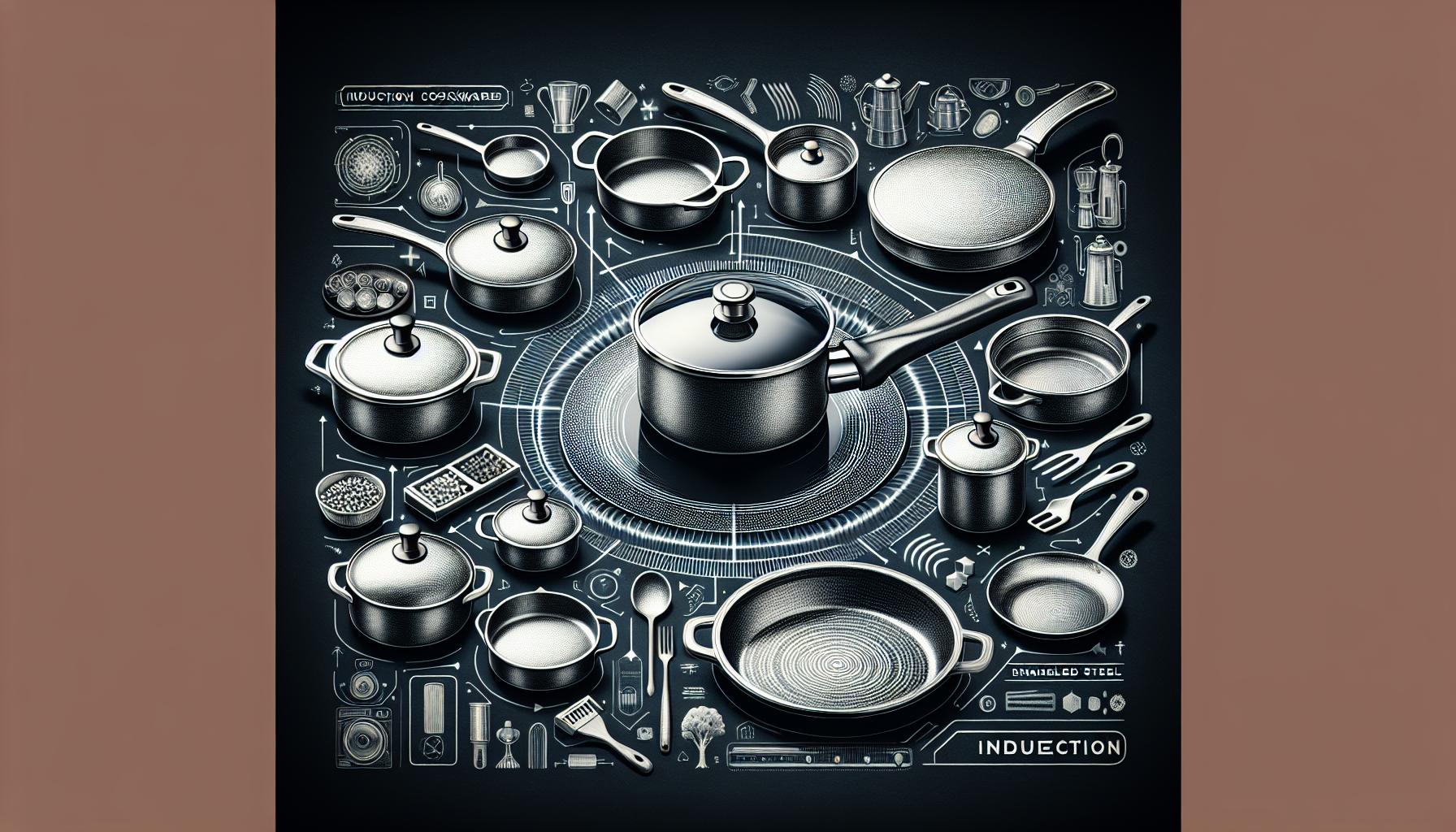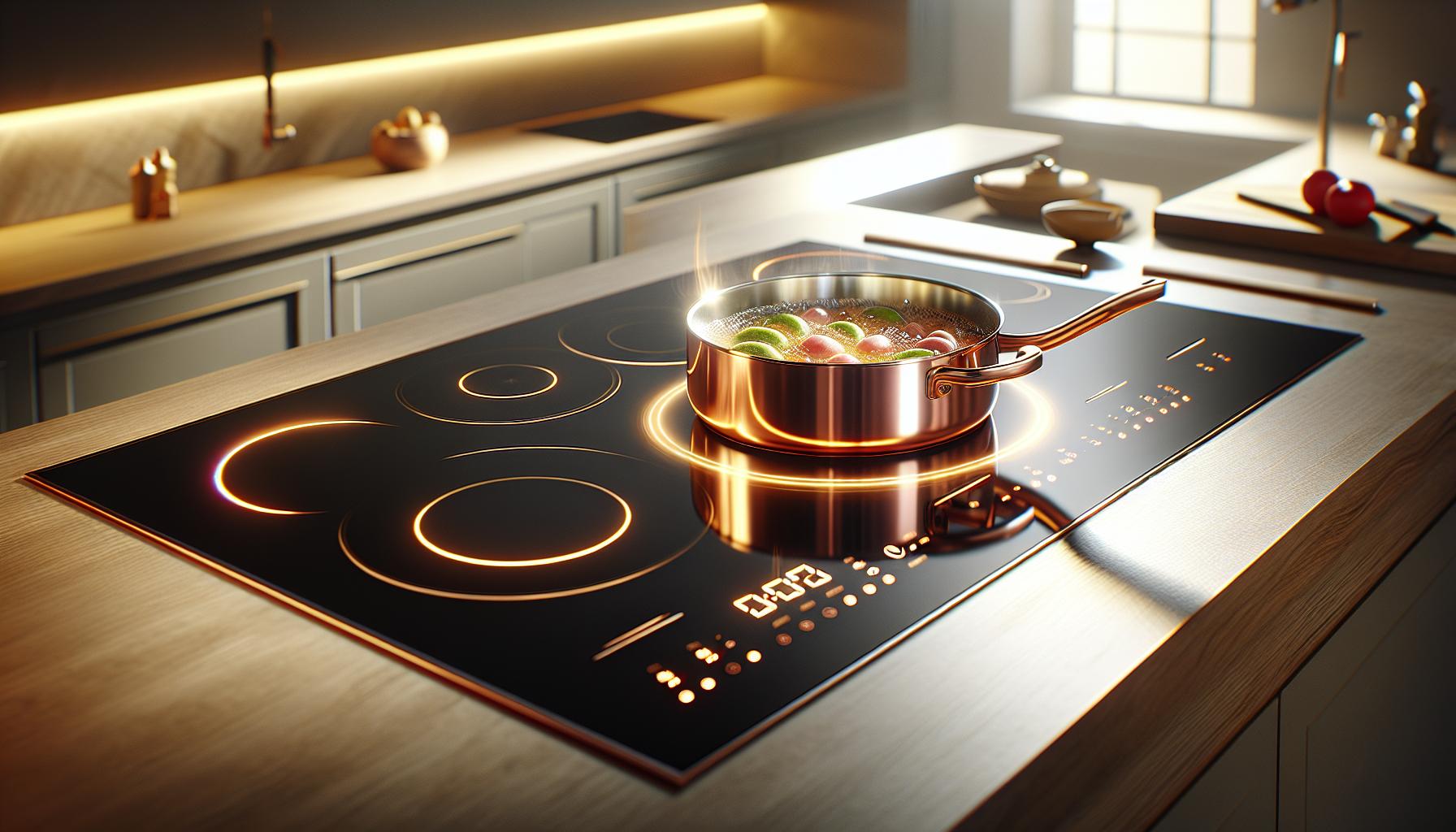This post contains affiliate links. See the affiliate disclaimer here.
If you’re a fan of copper cookware, you may be wondering if it’s compatible with induction cooktops. Induction cooking is becoming increasingly popular due to its energy efficiency and precision, but not all cookware is suitable for this type of stove.
Copper is an excellent conductor of heat, making it a popular choice for many chefs and home cooks. However, it’s important to understand whether or not copper cookware can be used on an induction cooktop before investing in a new set.
Fundamentals of Induction: Cooking Induction cooking works by using magnetic fields to create heat directly in the cookware.
This means that only cookware made from magnetic materials can be used on an induction cooktop. Copper, however, is not magnetic, which means that it won’t work on its own. However, there are ways to make copper cookware compatible with induction cooktops.
Compatibility of Copper with Induction Cooktops: To make copper cookware compatible with induction cooktops, manufacturers add a layer of magnetic material to the bottom of the pan. This allows the cookware to create heat through the magnetic field of the induction cooktop.
However, not all copper cookware is compatible with induction cooktops, so it’s essential to check the manufacturer’s specifications before purchasing.
Key Takeaways
- Copper cookware is not inherently compatible with induction cooktops due to its lack of magnetic properties.
- To make copper cookware compatible with induction cooktops, manufacturers add a layer of magnetic material to the bottom of the pan.
- It’s important to check the manufacturer’s specifications before purchasing copper cookware for use on an induction cooktop.

Fundamentals of Induction Cooking
Electromagnetic Fields and Cookware
Induction cooking is a process that uses electromagnetic fields to directly heat the cookware. When an electric current passes through a coil of wire, it creates an electromagnetic field. When a ferromagnetic material, such as iron, is placed in the field, it creates electrical currents within the material, which causes it to heat up. This is the basic principle behind induction cooking.
Not all cookware is suitable for induction cooking. Only cookware that is made of ferromagnetic materials, such as cast iron or stainless steel, can be used on an induction cooktop. Copper, aluminum, and glass cookware are not suitable for induction cooking, as they do not contain enough ferromagnetic material to heat up.
Induction Cooktop Design
Induction cooktops are designed with a flat, smooth surface that is easy to clean. The cooktop contains a coil of wire that is located beneath the surface. When an electric current is passed through the coil, it creates an electromagnetic field that heats the cookware. The cooktop contains sensors that detect the size and shape of the cookware, which allows it to adjust the heating accordingly.
Induction cooktops are more efficient than gas or electric cooktops, as they heat up the cookware directly, rather than heating up the air around it. This means that they are faster and more precise than other types of cooktops. Induction cooktops are also safer, as the surface does not get hot, which reduces the risk of burns and fires.
In conclusion, if you are planning to use an induction cooktop, you need to make sure that your cookware is made of ferromagnetic materials. Copper cookware is not suitable for induction cooking, as it does not contain enough ferromagnetic material to heat up. Induction cooktops are more efficient and safer than other types of cooktops, and they are a great choice for anyone who wants to cook quickly and easily.
Copper’s Properties Relevant to Induction Cooking
When it comes to induction cooking, copper cookware is a popular choice for many chefs and homeowners. However, copper is not a magnetic material, which means it may not work on induction cooktops. In this section, we will explore the properties of copper that are relevant to induction cooking.
Electrical Conductivity
Copper is an excellent conductor of electricity and heat. This makes it a preferred choice for many chefs as it allows for precise temperature control. However, when it comes to induction cooking, electrical conductivity is not relevant. Induction cooktops work by creating a magnetic field that interacts with the iron in the cookware, causing the cookware to heat up. Since copper is not magnetic, it cannot interact with the magnetic field, making it unsuitable for induction cooking.
Magnetic Permeability
Magnetic permeability is a material’s ability to become magnetized when exposed to a magnetic field. Copper has low magnetic permeability, which means it is not easily magnetized. This property makes copper unsuitable for induction cooking as it cannot interact with the magnetic field generated by the induction cooktop.
In conclusion, while copper cookware is an excellent conductor of heat and electricity, it is not suitable for induction cooking. Copper does not have the necessary magnetic properties to interact with the magnetic field generated by the induction cooktop. If you want to use copper cookware on your induction cooktop, look for copper cookware with a magnetic base or choose a different type of cookware altogether.
Compatibility of Copper with Induction Cooktops
Induction cooktops are gaining popularity due to their efficiency and speed. However, not all cookware is compatible with induction cooktops. Copper cookware, in particular, has been a topic of debate when it comes to its compatibility with induction cooktops.
Challenges with Pure Copper
Pure copper cookware is not compatible with induction cooktops because copper is not a ferromagnetic material. Induction cooktops work by creating a magnetic field that interacts with the iron in the cookware, causing the cookware to heat up. Since copper does not contain iron, the magnetic field cannot interact with it, making it unsuitable for induction cooking.
Copper-Clad Alternatives
Copper-clad cookware is an alternative to pure copper cookware that is compatible with induction cooktops. Copper-clad cookware has a layer of copper on the bottom, which provides the benefits of copper cookware, such as excellent heat conductivity and even heat distribution. The layer of copper is bonded to a layer of ferromagnetic material, such as stainless steel or aluminum, which makes the cookware compatible with induction cooktops.
When choosing copper-clad cookware for induction cooking, make sure that the layer of ferromagnetic material is thick enough to create a strong magnetic field. A thicker layer of ferromagnetic material will ensure that the cookware heats up evenly and quickly.
In conclusion, pure copper cookware is not compatible with induction cooktops, but copper-clad cookware is. When choosing copper-clad cookware for induction cooking, make sure that the layer of ferromagnetic material is thick enough to create a strong magnetic field.
Improving Copper Cookware for Induction
If you have copper cookware and want to use it on an induction cooktop, you may be wondering if it is possible. The answer is yes, but you need to make some modifications to your copper cookware to make it work on an induction cooktop.
Induction-Compatible Bases
Copper is not a ferromagnetic material, which means it cannot generate an electric current when exposed to a magnetic field. This is the reason why copper cookware does not work on an induction cooktop. However, some manufacturers have started producing copper cookware with induction-compatible bases.
An induction-compatible base is made of a layer of magnetic material, such as stainless steel or iron, that is bonded to the bottom of the copper cookware. This layer allows the cookware to generate an electric current when exposed to a magnetic field, making it compatible with induction cooktops.
Copper Cookware with Induction Discs
Another option to make your copper cookware work on an induction cooktop is to use an induction disc. An induction disc is a thin metal plate made of magnetic material that you can place on the cooktop, and then place your copper cookware on top of it.
The induction disc acts as a bridge between the cooktop and the copper cookware, allowing the cookware to generate an electric current and heat up. However, using an induction disc may not be as efficient as using induction-compatible cookware, as some of the heat generated by the cooktop may be lost in the transfer to the disc and then to the cookware.
In conclusion, if you want to use your copper cookware on an induction cooktop, you have two options: look for copper cookware with induction-compatible bases or use an induction disc. While both options can work, using induction-compatible cookware is generally more efficient and convenient.
Selecting Cookware for Induction Cooktops

When it comes to selecting cookware for induction cooktops, there are a few things to consider. In this section, we’ll discuss the material considerations and the shape and size of cookware that works best with induction cooktops.
Material Considerations
One of the most important things to consider when selecting cookware for induction cooktops is the material. As we know, induction cooktops work by generating a magnetic field that heats up the cookware directly. Therefore, the cookware must contain ferromagnetic materials. Copper, unfortunately, is not magnetic, so it won’t work on its own on an induction cooktop.
However, there are some copper cookware sets that work on induction cooktops. These sets are usually clad with magnetic metals, such as stainless steel, that allow them to work on induction cooktops. So, if you have a copper cookware set, check to see if it is compatible with induction cooktops.
Other materials that work well on induction cooktops include cast iron, enameled cast iron, and stainless steel. These materials are all magnetic and will work well on induction cooktops.
Cookware Shape and Size
Another consideration when selecting cookware for induction cooktops is the shape and size of the cookware. The cookware must have a flat bottom to make good contact with the cooktop. If the bottom of the cookware is not flat, it will not heat up properly and may even scratch the cooktop.
In addition, the size of the cookware should match the size of the heating element on the cooktop. If the cookware is too small, it will not heat up properly, and if it is too large, it may not fit on the cooktop at all.
To determine if your cookware is compatible with induction cooktops, you can use a magnet to test it. If the magnet sticks to the bottom of the cookware, it is compatible with induction cooktops.
In summary, when selecting cookware for induction cooktops, it is important to consider the material and the shape and size of the cookware. Copper cookware sets can work on induction cooktops if they are clad with magnetic metals, and other materials that work well include cast iron, enameled cast iron, and stainless steel. The cookware should have a flat bottom and match the size of the heating element on the cooktop.
Alternative Solutions for Copper Cookware Owners
If you have copper cookware and an induction cooktop, you may be wondering what your options are. While copper is not magnetic, there are a few alternative solutions that can allow you to continue using your copper cookware on an induction cooktop.
One option is to use an induction disc. An induction disc is a magnetic plate that you place on your induction cooktop. You can then place your copper cookware on top of the disc, and the disc will transfer the heat from the cooktop to the copper cookware. Induction discs are available in a variety of sizes and materials, so you can choose one that fits your cookware and your cooktop.
Another option is to use a copper-coated cookware. Copper-coated cookware has a layer of copper on the bottom, which allows it to conduct heat well. The rest of the cookware is made of a magnetic material, such as stainless steel, that can be used on an induction cooktop. Copper-coated cookware is a good option if you want the benefits of copper cookware, but also want to be able to use it on an induction cooktop.
Lastly, you can also consider replacing your copper cookware with induction-compatible cookware. While this may be a more expensive option, it can eliminate the need for any additional equipment or modifications. Induction-compatible cookware is made of a magnetic material, such as stainless steel or cast iron, and can be used on an induction cooktop.
Overall, there are a few alternative solutions for copper cookware owners who want to use their cookware on an induction cooktop. Whether you choose to use an induction disc, copper-coated cookware, or induction-compatible cookware, you can continue to enjoy the benefits of copper cookware while also taking advantage of the efficiency and precision of induction cooking.
Frequently Asked Questions
What types of cookware are suitable for induction cooktops?
Induction cooktops require cookware that is magnetic, which means that only ferromagnetic materials like cast iron and stainless steel can be used on them. Non-magnetic materials like copper, aluminum, and glass will not work on induction cooktops.
Can copper-bottomed pans be used on induction hobs with an adapter?
Copper-bottomed pans are not inherently magnetic, so they cannot be used directly on induction hobs. However, you can use an adapter disc made of magnetic material to convert your copper-bottomed pans into induction-compatible cookware. The adapter disc is placed on the induction hob, and the copper-bottomed pan is placed on top of the disc.
What is an induction converter plate and how does it work with non-induction cookware?
An induction converter plate is a disc made of magnetic material that is placed on an induction cooktop. Non-magnetic cookware like copper, aluminum, and glass can be placed on top of the converter plate, which then heats up and transfers heat to the cookware. The converter plate essentially acts as a bridge between the induction cooktop and the non-induction cookware.
Are there specific copper pans designed to be compatible with induction cooktops?
Yes, there are copper pans that are designed to be compatible with induction cooktops. These pans have a magnetic layer added to their base, allowing them to work on induction hobs without the need for an adapter disc.
Why are certain metals like copper and aluminum not inherently induction-ready?
Copper and aluminum are not inherently magnetic, which means that they cannot be directly heated by an induction cooktop. However, they can be made induction-compatible by adding a layer of magnetic material to their base.
How does the presence of a copper core in cookware affect its induction compatibility?
Cookware with a copper core can be used on induction cooktops if the base of the cookware is made of magnetic material. The copper core does not affect the induction compatibility of the cookware, as long as it is surrounded by a layer of magnetic material.

